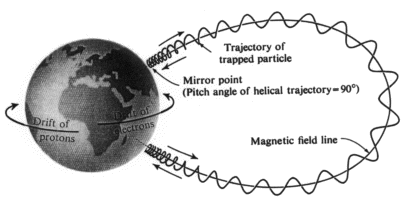List of artificial radiation belts
Artificial radiation belts are radiation belts that have been created by high altitude nuclear explosions.[1][2][3][4][5]
| Explosion | Location | Date | Yield (approximate) | Altitude (km) | Nation of Origin |
|---|---|---|---|---|---|
| Hardtack Teak | Johnston Island (Pacific) | 1958-08-01 | 3.8 megatons | 76.8 | United States |
| Hardtack Orange | Johnston Island (Pacific) | 1958-08-12 | 3.8 megatons | 43 | United States |
| Argus I | South Atlantic | 1958-08-27 | 1-2 kilotons | 200 | United States |
| Argus II | South Atlantic | 1958-08-30 | 1-2 kilotons | 256 | United States |
| Argus III | South Atlantic | 1958-09-06 | 1-2 kilotons | 539 | United States |
| Starfish Prime | Johnston Island (Pacific) | 1962-07-09 | 1.4 megatons | 400 | United States |
| K-3 | Kazakhstan | 1962-10-22 | 300 kilotons | 290 | USSR |
| K-4 | Kazakhstan | 1962-10-28 | 300 kilotons | 150 | USSR |
| K-5 | Kazakhstan | 1962-11-01 | 300 kilotons | 59 | USSR |
The table above only lists those high-altitude nuclear explosions for which a reference exists in the open (unclassified) English-language scientific literature to persistent artificial radiation belts resulting from the explosion.
The Starfish Prime radiation belt had, by far, the greatest intensity and duration of any of the artificial radiation belts.[1]
The Starfish Prime radiation belt damaged the United Kingdom Satellite Ariel 1 and the United States satellites, Traac, Transit 4B, Injun I and Telstar I. It also damaged the Soviet satellite Cosmos V. All of these satellites failed completely within several months of the Starfish detonation.[1]
Telstar I lasted the longest of the satellites damaged by the Starfish Prime radiation, with its complete failure occurring on February 21, 1963.[6]
In Los Alamos Scientific Laboratory report LA-6405, Herman Hoerlin gave the following explanation of the history of the original Argus experiment and of how the nuclear detonations lead to the development of artificial radiation belts.[1]
Before the discovery of the natural Van Allen belts in 1958, N. C. Christofilos had suggested in October 1957 that many observable geophysical effects could be produced by a nuclear explosion at high altitude in the upper atmosphere. This suggestion was reduced to practice with the sponsorship of the Advanced Research Project Agency (ARPA) of the Department of Defense and under the overall direction of Herbert York, who was then Chief Scientist of ARPA. It required only four months from the time it was decided to proceed with the tests until the first bomb was exploded. The code name of the project was Argus. Three events took place in the South Atlantic. ... Following these events, artificial belts of trapped radiation were observed.
A general description of trapped radiation is as follows. Charged particles move in spirals around magnetic-field lines. The pitch angle (the angle between the direction of the motion of the particle and direction of the field line) has a low value at the equator and increases while the particle moves down a field line in the direction where the magnetic field strength increases. When the pitch angle becomes 90 degrees, the particle must move in the other direction, up the field lines, until the process repeats itself at the other end. The particle is continuously reflected at the two mirror points — it is trapped in the field. Because of asymmetries in the field, the particles also drift around the earth, electrons towards the east. Thus, they form a shell around the earth similar in shape to the surface formed by a field line rotated around the magnetic dipole axis.

In 2010, the United States Defense Threat Reduction Agency issued a report that had been written in support of the United States Commission to Assess the Threat to the United States from Electromagnetic Pulse Attack. The report, entitled "Collateral Damage to Satellites from an EMP Attack," discusses in great detail the historical events that caused artificial radiation belts and their effects on many satellites that were then in orbit. The same report also projects the effects of one or more present-day high altitude nuclear explosions upon the formation of artificial radiation belts and the probable resulting effects on satellites that are currently in orbit.[7]
See also
References
- Hoerlin, Herman (October 1976). United States High-Altitude Test Experiences: A Review Emphasizing the Impact on the Environment (PDF) (Report). Los Alamos Scientific Laboratory. doi:10.2172/7122163. LA-6405. Archived (PDF) from the original on 2009-03-16. Retrieved 2009-10-25.
- Hess, Wilmot N. (September 1964). The Effects of High Altitude Explosions (PDF) (Technical report). National Aeronautics and Space Administration. NASA TN D-2402. Archived (PDF) from the original on 2015-05-18. Retrieved 2009-10-24.
- Zak, Anatoly (March 2006). "The K Project: Soviet Nuclear Tests in Space". The Nonproliferation Review. 13 (1): 143–150. doi:10.1080/10736700600861418.
- Operation ARGUS (Fact Sheet) (PDF) (Report). U.S. Defense Threat Reduction Agency. November 2006. Archived from the original (PDF) on 2012-10-07. Retrieved 13 May 2015.
- Jones, C. B.; Doyle, M. K.; Berkhouse, L. H.; Calhoun, F. S.; Martin, E. J. (30 April 1982). Operation Argus: 1958 (PDF) (Technical report). Defense Nuclear Agency. DNA 6039F. Archived from the original (PDF) on 30 January 2012. Retrieved 13 May 2015.
- National Space Science Data Center. "Telstar 1". NSSDC 1962-029A. Retrieved 2009-10-25.
- Conrad, Edward E.; Gurtman, Gerald A.; Kweder, Glenn; Mandell, Myron J.; White, Willard W. (August 2010). Collateral Damage to Satellites from an EMP Attack (PDF) (Technical report). Defense Threat Reduction Agency. DTRA-IR-10-22. Archived (PDF) from the original on 2011-11-12. Retrieved 2011-06-19.
External links
- Wm. Robert Johnston. High-altitude nuclear explosions
